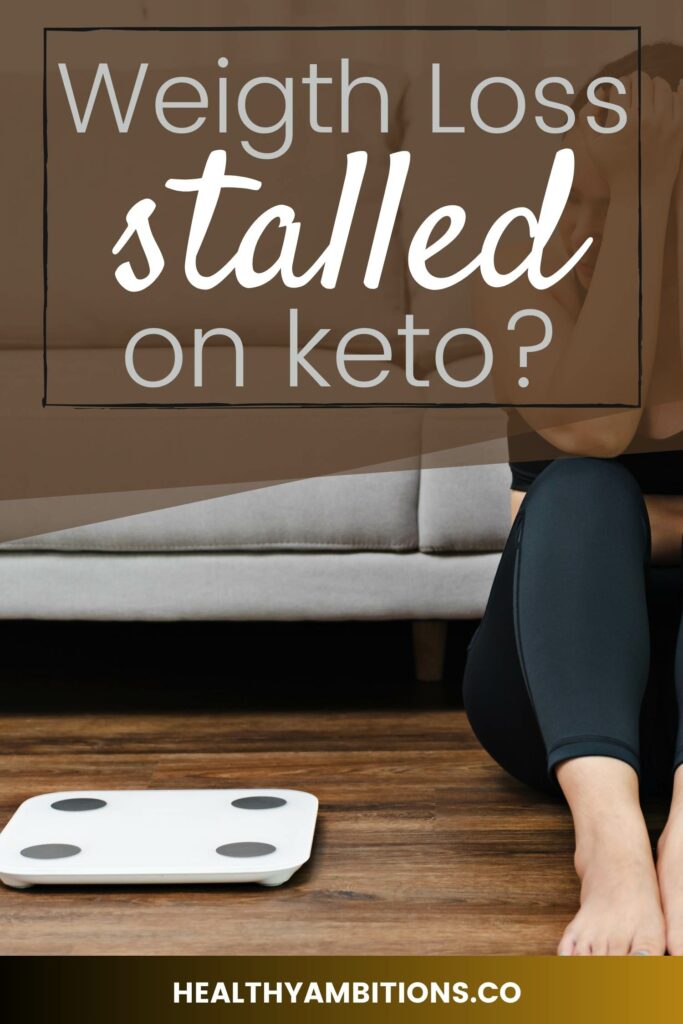How to Break a Weight Loss Plateau on Keto
You’ve started the ketogenic diet and it’s been quite the ride. You dove headfirst into this low-carb, high-fat lifestyle, ready to reap the benefits – improved energy levels, sharper mental clarity, and, of course, weight loss.
Things were going great – until suddenly, they weren’t. Despite sticking to your keto plan, the once steadily dropping numbers on the scale have come to a screeching halt.
You’ve hit the dreaded weight loss plateau on keto.
This can feel a bit like running full-speed into a brick wall, especially when you’ve been putting in the effort and were seeing results.
It’s as if you’ve been following the weight loss map perfectly, only to find yourself at an unexpected roadblock with no detour in sight.
But let’s hit pause for a moment and take a deep breath. Despite feeling frustrating and somewhat disheartening, this weight loss plateau on keto is quite a common occurrence and one that can be surpassed.
It’s not a dead-end, but rather a temporary pit-stop in your keto journey.
This is where we come in, armed with tips, suggestions, and a heap of understanding. We’re here to help you understand this plateau, equip you with strategies to overcome it, and get you back on track to achieving your weight loss goals.

This post may contain affiliate links, which helps keep this content free. Please read our disclosure for more info.
Understanding the Weight Loss Plateau
What’s the deal with this weight loss plateau on keto?
In the simplest terms, a weight loss plateau refers to a period of time during your keto journey where, despite your best efforts and adherence to the diet, your weight stubbornly refuses to budge.
It might feel as though your body is playing a cruel joke on you, especially when you’ve been so disciplined with your food choices and lifestyle changes.
But before you throw in the towel, it’s essential to understand that hitting a weight loss plateau is a normal part of any weight loss process, not just keto.
Our bodies are incredibly smart and adaptable. When you initially switch to a lower calorie intake, your body responds by shedding weight.
However, after some time, your body adapts to these changes, entering a state of equilibrium where it’s expending energy at the same rate you’re consuming it. This is when you experience a weight loss plateau.
But don’t worry, this does not mean you’re doomed to remain stuck at this weight forever. This plateau is not a reflection of your efforts nor a reason to be disheartened.
It’s merely a sign that it might be time to reassess your approach and make some tweaks to get that scale moving again.
The key is understanding that it’s manageable and not a dead-end. With a few adjustments and a continued commitment to your keto lifestyle, you can successfully overcome this plateau.
Evaluating Your Keto Approach
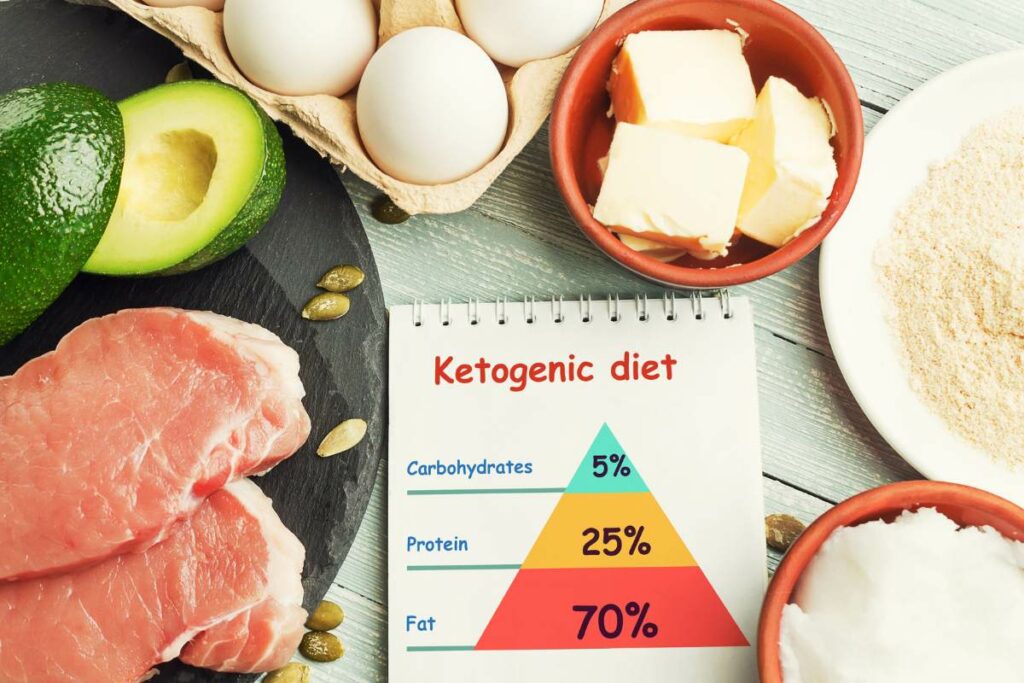
As you move forward on your keto path, hitting a weight loss plateau can be an opportunity to take a step back and re-evaluate your current approach.
It’s about understanding your body’s responses and learning how to fine-tune your diet to continue towards your goal.
This evaluation requires you to look at several aspects of your keto lifestyle – from your macronutrient distribution and calorie intake to potential hidden carbs that could be silently sabotaging your progress.
Track Your Macros
Understanding and tracking your macronutrients – or “macros” – is a crucial aspect of the ketogenic diet.
When we say macros, we’re referring to the three key types of nutrients your body uses in large amounts: fats, proteins, and carbohydrates.
The ketogenic diet is known for its low-carb, high-fat approach, but that doesn’t mean you should be slashing carbs and loading up on fats without keeping an eye on the overall picture.
While it’s true that a significant part of your caloric intake on keto comes from fats, it’s also crucial to ensure you’re getting enough protein to maintain muscle mass.
As for carbs, the aim is to limit them to a level that allows your body to enter and stay in a state of ketosis.
This is where macro tracking comes into play. By keeping a log of what you’re eating, you can ensure you’re hitting the right macro ratios for your body and your weight loss goals.
There are many apps and online tools available that can make tracking your macros straightforward and easy.
It’s important to remember that every person’s macro needs can differ based on various factors like age, sex, weight, and activity level.
However, a general guideline for macro distribution on a standard ketogenic diet is about 70-75% of calories from fats, 20-25% from protein, and 5-10% from carbs.
If you’ve hit a weight loss plateau on keto, take a close look at your macros. There could be an imbalance that’s keeping you from losing more weight.
Maybe you’re getting more carbs or less protein than you need, or perhaps your fat intake is off. Adjusting these ratios could potentially be the key to overcoming your weight loss stall.
Check Your Calorie Intake

It’s easy to get caught up in the macronutrient ratios of the ketogenic diet and forget about the basics of weight loss, which at its core, revolves around calories in versus calories out.
Yes, even on a ketogenic diet, the number of calories you consume matters.
Contrary to some misconceptions, following a keto diet doesn’t grant a free pass to consume an unlimited amount of calories.
Regardless of where those calories come from – be it fats, proteins, or carbs – consuming more than your body needs can lead to weight gain or, in this case, halt your weight loss progress.
The ketogenic diet works for weight loss because it naturally helps regulate your appetite and reduce calorie intake.
The high fat and moderate protein levels keep you satiated for longer, reducing the need to snack or overeat.
However, as with any diet, it’s still possible to over-consume calories, especially when eating calorie-dense foods that are common in a keto diet, like cheese and nuts.
If you’ve hit a weight loss plateau on keto, it might be worth taking a closer look at your daily caloric intake. Have you been eating more than usual? Have your portion sizes slowly crept up without you realizing?
If so, a small tweak in your daily calories might be all it takes to get the scale moving in the right direction again.
Creating a calorie deficit – consuming fewer calories than your body needs to maintain its current weight – is essential for weight loss.
Adjust your calorie intake accordingly, but make sure it’s done in a healthy and sustainable way, avoiding extreme calorie restrictions that could do more harm than good.
Uncover Hidden Carbs

Even if you’re diligent about avoiding obvious carb-heavy foods like bread, pasta, and sugary treats, you might be surprised to find out that some “keto-friendly” foods could be secretly bumping up your carb intake.
These hidden carbs can be a sneaky culprit behind a weight loss plateau on keto.
Products marketed as “low-carb” or “sugar-free” may seem like safe choices, but they often contain more carbs than you’d think.
Even some natural foods can be surprisingly high in carbs. Certain vegetables, nuts, seeds, and dairy products may have more carbs than you realize, especially when consumed in larger quantities.
So how do you spot these hidden carbs? Start by becoming a master at reading nutritional labels. Look beyond the marketing claims on the front of the package and dive into the nutritional facts.
Keep an eye out for added sugars, starches, and other carb-rich ingredients. Also, don’t forget to consider serving sizes. What may seem like a low-carb food can quickly become high-carb if the serving size is smaller than you realize.
Finally, be mindful of your food choices. It’s not just about how much you eat, but also what you eat.
Choosing whole, unprocessed foods is a good strategy to avoid hidden carbs. These foods are generally lower in carbs and higher in fiber compared to processed foods.
By uncovering and accounting for these hidden carbs, you can ensure your diet truly is keto and help push past the weight loss plateau.
Implementing Changes in Your Diet
Once you’ve evaluated your current approach and identified potential areas for improvement, the next step is to start making those changes.
It’s all about fine-tuning your keto diet to better align with your weight loss goals. This isn’t about drastic overhauls but rather thoughtful modifications to your diet.
Implementing these changes might seem daunting at first, but remember, it’s all part of the journey to breaking through your weight loss plateau on keto.
Consider Carb Cycling

Carb cycling is a dietary approach that involves alternating between low-carb days (similar to a standard ketogenic diet) and high-carb days.
This strategy is often used by athletes or bodybuilders to optimize their workouts and performance, but some people find it helpful for weight loss too.
The idea behind carb cycling is to shock your body out of the adaptation phase that might be causing your weight loss plateau.
By adding in higher-carb days, you are essentially ‘reminding’ your body that carbohydrates are available, which may lead to increased fat burning once you return to your low-carb days.
However, while this method might be effective for some, it’s not for everyone. Cycling out of ketosis can make it harder for some people to get back into it, and the fluctuating dietary changes can potentially lead to cravings and overeating.
It’s also a more complex dietary approach that requires careful planning to ensure you’re still meeting your nutritional needs on both low-carb and high-carb days.
Personally, I’m not the biggest fan of this method. I believe that consistency is key when it comes to weight loss and overall health.
That said, everyone’s body is different and what works for one person might not work for another.
If you’re curious about carb cycling and feel like it could be a good fit for you, consider trying it out but be sure to monitor your body’s responses and progress closely.
Increase Protein Intake
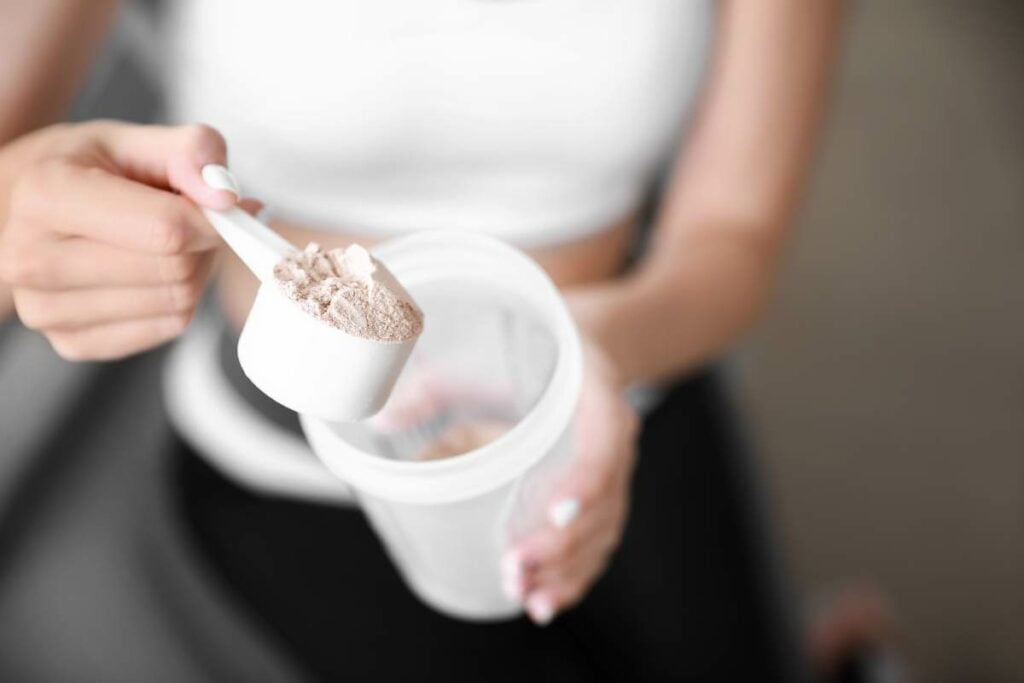
One of the common missteps in a ketogenic diet is not getting enough protein.
While it’s true that the majority of your calories on keto come from fats, protein still plays an essential role in your diet.
Increasing your protein intake can potentially help break your weight loss plateau on keto. Here’s why: protein is crucial for maintaining and building muscle mass.
When you lose weight, you don’t just lose fat. Some of the weight loss can also be muscle. By increasing your protein intake, you can help preserve your muscle mass, even as you lose weight.
But there’s another reason why boosting your protein can help with weight loss: protein has a high thermic effect, meaning your body uses more energy (calories) to digest it compared to fats and carbs. In other words, you burn more calories when you eat more protein.
Plus, protein is satiating, which means it helps you feel full and satisfied. This can lead to reduced appetite and lower calorie intake overall.
Consider slightly increasing your protein intake and see how your body responds. This doesn’t mean you need to start eating protein at every meal or drastically reduce your fat intake.
But a small adjustment, such as adding a bit more protein to your meals or swapping a high-fat snack for a protein-rich one, could make a difference.
Include Fiber and Veggies
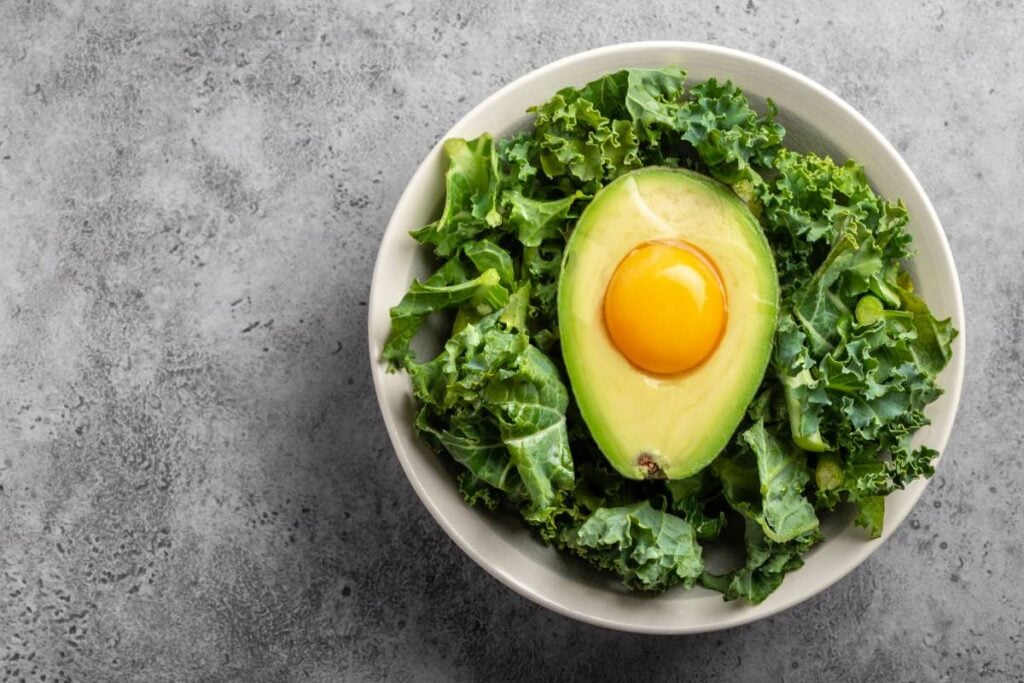
In the world of dieting, there are endless debates and controversies, and the necessity of fiber is no exception.
While fiber is often hailed for its benefits in digestive health, appetite control, and nutrient absorption, it’s also true that many people on restrictive diets – such as the carnivore diet – report doing well without it.
However, for those following a ketogenic diet, fiber and vegetables can still offer several potential benefits, even if they aren’t strictly ‘necessary’.
For one, fiber can contribute to feelings of fullness, potentially helping to control hunger and manage calorie intake, which could be beneficial if you’re hitting a weight loss plateau.
Not only that, but fiber feeds the beneficial bacteria in your gut, supporting a healthy gut microbiome.
While a healthy gut can indeed be maintained on a carnivore diet or a very low-fiber diet, some people may find that a moderate intake of fiber helps with digestive regularity and gut health.
Plus, vegetables offer a variety of micronutrients, which can contribute to overall health and well-being.
While you can get these micronutrients from other sources on a keto or carnivore diet, vegetables can be a convenient and low-calorie way to include them in your diet.
In the end, whether to include more fiber and veggies in your diet is a personal decision based on your dietary preferences, health goals, and how your body responds.
If you’re facing a weight loss plateau on keto, it could be worth experimenting with your fiber and vegetable intake – perhaps by including more low-carb veggies in your meals, or trying a period of lower fiber intake – to see how it impacts your weight loss and overall well being.
Try Intermittent Fasting

Intermittent fasting (IF) has been gaining popularity as a potent strategy to boost weight loss and improve health.
When paired with the ketogenic diet, it could potentially be the missing puzzle piece to help you break through your weight loss plateau on keto.
Intermittent fasting is not a diet in itself, but rather an eating pattern that cycles between periods of eating and fasting.
There are several methods of intermittent fasting, but the most popular ones include the 16/8 method (fasting for 16 hours and eating during an 8-hour window), the 5:2 method (eating normally for 5 days of the week and restricting calories for 2 days), and the eat-stop-eat method (one or two 24-hour fasts per week).
So, how does intermittent fasting help with weight loss? There are a few mechanisms at play.
By reducing your eating window, you are likely to consume fewer calories over the course of the day, which can lead to weight loss.
Fasting can cause hormonal changes that enhance metabolism and promote fat loss. These changes include reductions in insulin levels, increases in growth hormone levels, and enhanced fat burning.
Adding intermittent fasting to your keto regimen can give your body the extra push it needs to start shedding pounds again.
This is because the combination of a ketogenic diet and intermittent fasting can help your body become even more efficient at burning fat for fuel.
It’s important to remember, though, that intermittent fasting is not suitable for everyone. Certain people, such as those with specific health conditions, pregnant or breastfeeding women, and those with a history of eating disorders, should not try intermittent fasting without medical supervision.
If you’re considering incorporating intermittent fasting into your routine, start slow. Try a shorter fasting period at first and listen to your body.
It might take some time to adjust, but with patience, you could find that intermittent fasting is a game-changer in overcoming your weight loss plateau on keto.
Incorporating Physical Activity

While diet is indeed the key player in weight loss, physical activity brings a lot to the table as well.
Exercise not only burns calories but also builds muscle, which can help boost your metabolism. As you explore ways to break your weight loss plateau on keto, consider the role of physical activity in your routine.
Exercise is Essential
There’s no denying the value of regular physical activity when it comes to weight loss and overall health.
It boosts your metabolism, increases your energy levels, improves your mood, and can even help curb your appetite. These benefits make it an essential strategy for breaking your weight loss plateau on keto.
While the type of exercise can vary greatly depending on your preferences, abilities, and goals, what’s important is finding a routine that you genuinely enjoy and can stick to consistently.
Consistency, after all, is what truly brings results in the long term.
For some, this might mean getting outside for a brisk walk or jog every day. Others might prefer strength training or high-intensity interval training (HIIT) workouts. Still others might find that activities like yoga, swimming, or dance classes are a perfect fit.
Consider this: exercise doesn’t have to feel like a chore. If you love what you’re doing, it will be much easier to make it a regular part of your lifestyle. Experiment with different types of workouts until you find the one that excites you.
If you’re new to exercise or have been out of the game for a while, remember to start slow. Gradually increase the intensity and duration of your workouts to avoid injuries and burnout.
The combination of a well-formulated ketogenic diet and regular physical activity can be powerful for breaking through a weight loss plateau.
While diet is the cornerstone of weight loss, exercise adds an extra layer that can help accelerate your progress and improve your overall well-being.
Manage Stress and Sleep Well

Amid the focus on diet and exercise, two often overlooked elements of a successful weight loss plan are stress management and quality sleep.
These two factors may not seem directly related to weight loss, but they can have a significant impact on your ability to shed pounds and break through a weight loss plateau on keto.
Let’s start with sleep. Getting enough quality sleep is critical for your body’s overall health and functioning, including its ability to lose weight.
When you’re sleep-deprived, your body’s hormonal balance can be thrown off, potentially leading to increased hunger and cravings, decreased metabolism, and even a higher risk of weight gain.
Not only that but when you’re tired, you might find it harder to make healthy food choices and stay committed to your exercise routine.
To ensure you’re getting the rest you need, aim for 7 to 9 hours of sleep per night. Establish a regular sleep schedule, create a relaxing pre-bedtime routine, and make your sleep environment as comfortable and distraction-free as possible.
Now, onto stress. Chronic stress can interfere with your weight loss efforts in a few ways. It can lead to emotional eating, promote fat storage in your body, and even make it harder to lose weight.
Plus, when you’re stressed out, you might find it more challenging to stick to your keto diet or exercise plan.
To keep stress in check, consider incorporating stress-management techniques into your routine.
This could include activities like yoga, meditation, deep-breathing exercises, journaling, or simply spending time on a hobby you love. Regular physical activity can also be a great stress reliever.
Keep in mind that everyone has different stressors and ways of managing them, so it’s important to find strategies that work for you.
You may also find it helpful to seek support from a mental health professional if stress is a significant issue in your life.
Don’t underestimate the power of a good night’s sleep and a calm mind when it comes to breaking your weight loss plateau on keto. By prioritizing rest and relaxation, you’re not only supporting your weight loss goals but also promoting overall health and well-being.
Troubleshooting Common Mistakes
While the ketogenic diet has been proven to be effective for weight loss, it’s also a bit of a balancing act. Even small missteps can sometimes halt progress and lead to a weight loss plateau on keto.
Balance Your Fats

While the ketogenic diet is undoubtedly high in fats, it’s important to remember that more isn’t always better.
Yes, fats are your main source of energy on keto, but consuming them in excess could lead to a caloric surplus, preventing weight loss or even causing weight gain. This could potentially contribute to your weight loss plateau on keto.
And, it’s not just about the quantity of fats but also about the quality and balance with other macronutrients.
Ensuring that you consume a mix of high-quality fats from sources like avocados, nuts, seeds, and olive oil can be beneficial.
It’s also crucial to balance fat intake with adequate protein, which is necessary for maintaining muscle mass and can help keep you feeling full.
So, how do you strike this balance? It starts with understanding your personal macronutrient needs, which can vary based on factors like your age, sex, weight, activity level, and weight loss goals.
Tools and calculators are available online to help estimate these needs. Alternatively, a dietitian or nutritionist can provide personalized guidance.
Once you know your macronutrient targets, tracking what you eat can help ensure you’re hitting them.
There are several food-tracking apps available that can make this easier. It’s not about striving for perfection, but rather about making consistent, mindful choices that support your health and weight loss goals.
Balancing your fats is a key step in overcoming a weight loss plateau on keto. By paying attention to both the quantity and quality of fats in your diet, and by balancing them with protein and a controlled amount of carbs, you can help your body get back on track with weight loss.
Limit Alcohol and Artificial Sweeteners

Alcohol and artificial sweeteners can be tricky terrain when navigating a ketogenic diet. Even though some options might seem keto-friendly, they can potentially hinder your progress and contribute to a weight loss plateau on keto.
With alcohol, the main issue lies in its effects on metabolism. When you consume alcohol, your body prioritizes metabolizing it over other nutrients, including fats.
This means that your body’s fat-burning abilities are put on pause while it deals with the alcohol. Additionally, many alcoholic drinks are high in carbs or sugar, which can potentially kick you out of ketosis.
Alcohol can stimulate your appetite and lower your inhibitions, making you more likely to overeat.
For artificial sweeteners, the problem is not as straightforward. While these sweeteners are often marketed as zero-calorie, they can sometimes cause a similar insulin response as sugar, which could potentially impact your ketosis status.
Some studies suggest that artificial sweeteners could stimulate hunger and cravings, leading to higher calorie consumption overall.
So, what can you do about this? As a general rule, consider limiting your alcohol intake and opting for low-carb options when you do choose to drink.
As for artificial sweeteners, try to limit them as well and embrace the natural flavors of your food.
If you’re finding it hard to cut them out completely, consider using natural, low-carb sweeteners like stevia or erythritol.
By keeping an eye on your alcohol and artificial sweetener intake, you can make sure they’re not the culprits behind your weight loss plateau on keto.
The aim of the ketogenic diet is to promote overall health alongside weight loss, and consuming these substances in moderation aligns with that goal.
Stay Hydrated

Water is often called the body’s “life source,” and for good reason. It’s vital for nearly all of our body’s functions, including metabolism, which is essential for weight loss.
When you’re well-hydrated, your body can effectively metabolize fats, keeping your weight loss efforts on track.
Plus, water plays a crucial role in helping your kidneys and liver function efficiently, aiding in detoxification, which can be especially important during a dietary shift like moving to a ketogenic diet.
Hydration can help manage your hunger levels. Sometimes, what we perceive as hunger is actually thirst in disguise.
By staying properly hydrated, you can help prevent these false hunger signals and avoid unnecessary snacking, aiding in your weight loss efforts.
Drinking plenty of water is particularly important on a ketogenic diet due to the diuretic effect of this eating plan.
As you cut carbs and your body burns through its glycogen stores, it releases water, increasing your need for hydration.
A good starting point is to aim for 8 glasses (64 ounces) of water a day, but your needs may vary depending on factors like your weight, activity level, and climate.
It’s important to listen to your body’s signals. If you’re feeling thirsty, drink up!
And don’t forget, water isn’t the only way to hydrate. Foods, especially water-rich vegetables also contribute to your daily hydration. Plus, beverages like herbal tea or bone broth can be hydrating and align well with a ketogenic lifestyle.
Seeking Professional Help

If you’ve tried everything and still can’t break your weight loss plateau on keto, it might be time to bring in the professionals.
Seeking help from a dietitian or a healthcare provider can provide additional guidance, personalized advice, and support to help you overcome this hurdle.
Weight loss isn’t a one-size-fits-all journey, and what works for one person might not work for another. Personalized advice based on your specific health history, body composition, lifestyle, and goals can make a significant difference in your progress.
A registered dietitian or nutritionist specializing in ketogenic diets can assess your current eating patterns, make necessary adjustments, and guide you toward a plan that suits you best.
A healthcare provider can help rule out any medical conditions that might be hindering your weight loss efforts.
Conditions such as thyroid disorders, insulin resistance, and hormonal imbalances can affect your metabolism and make weight loss more challenging. A healthcare provider can order the appropriate tests and provide treatment if needed.
It’s essential to remember that seeking professional help is not a sign of failure or defeat. Instead, it’s a proactive step towards understanding your body better and tailoring your approach to its unique needs.
Conquering Your Goals with the Keto 21-Day Fat Loss Challenge
Getting past a weight loss plateau on keto might feel like climbing a mountain, but we’ve got a secret weapon to help you reach the summit.
The Keto 21-Day Fat Loss Challenge is a unique program designed for women who are ready to drop those extra pounds fast.
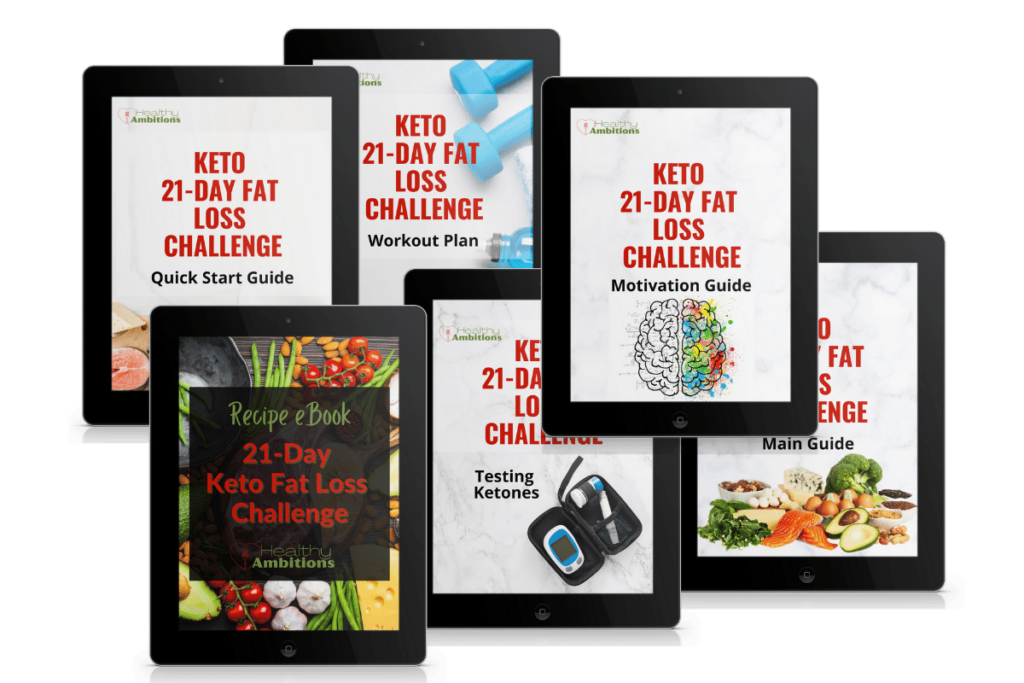
Packed with valuable insights and practical steps, it’ll equip you to not only understand the science behind weight loss but also master the art of healthy eating and stay motivated throughout your journey.
This program comes complete with a comprehensive guide, a strategic diet plan, and an optional at-home workout regimen.
What sets this challenge apart is its focus on personal goals and providing an approach that doesn’t feel like a traditional restrictive “diet.”
So are you ready to rise above the weight loss plateau on keto? Take on the Keto 21-Day Fat Loss Challenge and see how the scales start tipping in your favor!
